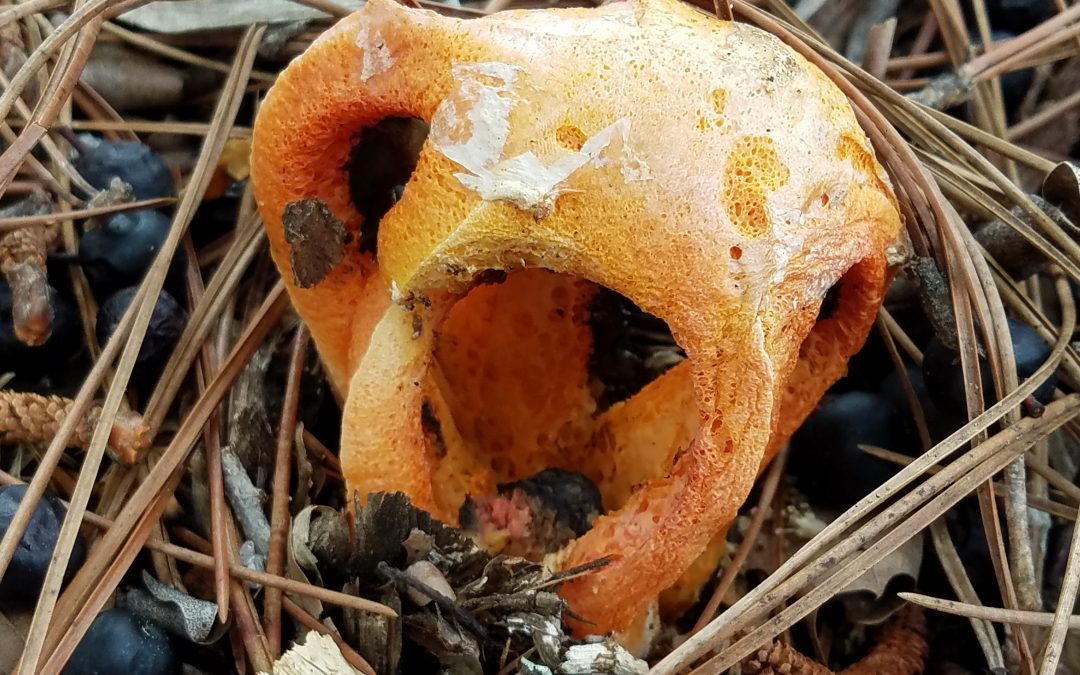
by Evan Anderson | Jul 1, 2021
While there are many fungi that produce mushrooms out in the world around us, there are some that are particularly notable. Edible varieties such as the lion’s mane, jelly ear, and chanterelle may be welcome additions to the landscape. We may have to look out for harmful fungi that cause leaf spots on our landscape plants, toxic mushrooms that could cause harm if ingested, or even things like sooty mold that indicate the presence of another problem (plant-damaging insects, in that case). Then, there are stinkhorn mushrooms.
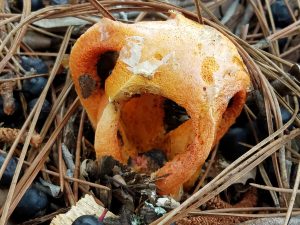
Stinkhorn Mushroom. Photo courtesy of Evan Anderson.
While not poisonous (indeed, some varieties are edible) and not harmful to plants, these mushrooms are usually unwanted by homeowners. Why? There are two things that make them undesirable. First, they emit an odor that may resemble rotting meat, raw sewage, or some delightful combination of the two. Secondly, some species strongly resemble…well, the genus name Phallus may give some indication. Suffice to say that if your landscape mulch appears to have an inappropriate anatomical addition after a cool rain, you may have a stinkhorn mushroom.
These fungi are decomposers of dead plant material, breaking down wood chips, fallen leaves, or old tree stumps. This is an incredibly important role in the ecosystem, but stinkhorns are particularly offensive as they go about doing their job. The reason for their smell, specifically, is because they need to spread their spores. To do so, they attract insects. Unlike many plants which use beautiful flowers with pleasant fragrances to attract pollinators, stinkhorns attract a different crowd of helpers. They exude a slimy mass of spores that are appealing to flies and other invertebrates that enjoy feces, dead animals, and the like. The insects transport spores from place to place as they feed on the slime.
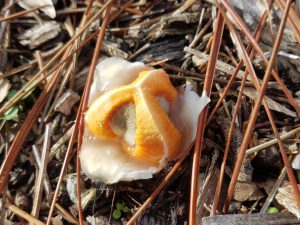
Stinkhorn Mushroom. Photo courtesy of Evan Anderson.
If you smell or see these mushrooms in your yard or landscape, don’t worry. They won’t last long and may be beneficial to the environment. If they become intolerable, stirring mulch up can help discourage their growth, or they can be removed physically (perhaps with a tool or while wearing gloves, at least). If they recur in an area time after time, look out for their early stages of growth, which may resemble puffballs or small eggs, and remove them then. Fungicides tend not to be effective and may harm other beneficial fungi in the environment.
For more information, see our EDIS publication on stinkhorn mushrooms at https://edis.ifas.ufl.edu/publication/PP345.
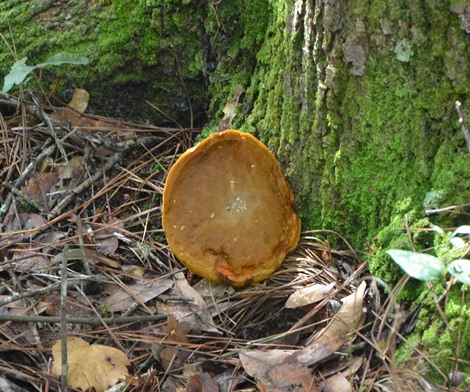
by Les Harrison | Oct 8, 2019

Mushrooms growing on the roots of trees is a bad sign. This indicates the roots are decaying and the tree will soon become (or already is) unsafe.
On the doorstep of autumn, the weather is making its seasonal change in north Florida. It has been a bit cooler in the mornings, but the afternoons still qualify as hot.
What the winds of October will blow in is still anyone’s guess, but last year it was Hurricane Michael. Unfortunately, the storm’s brunt came in causing severe damage to homes, businesses and marine enterprises in several counties.
October is typically the month when tropical cyclone activity lessens in the Atlantic, but accelerates in the Gulf of Mexico. While beastly events like Hurricane Michael are relatively rare, it only takes one such incident to necessitate recovery efforts and expenses for years, if not decades.
The prudent course of action is to prepare for the worst while hoping for the best. One area of preparation where residents can have a distinctly positive effect is readying their trees for the potential assault.
Damage from falling trees and limbs is a major cause of destruction during tropical storms and hurricanes. Removing potential problems before the storm can minimize harm to structures and injury to residents.
Trees in decline are especially hazardous. Their compromised health makes them subject to uprooting and breakage with far less force than would effect a healthy tree.
There are several key indicators for tree health. Any single factor or a combination can mark a tree as unsafe.
Mushrooms growing on or very close to trees is a sign the tree is dying. The fungus is not the cause of decline, but only an indicator of the eventual fate.
Spores of the mushrooms are scattered by wind and water. Landing randomly, most arrive on a site devoid of necessary resources and never sprout.
Those lucky spores which land on decaying wood will likely sprout and take nourishment from the rotting plant material. Their roots accelerate the decomposition of the wood by consuming the available material and exposing more of the tree to colonization by mushrooms.
Sites on trees and plants infected with mushrooms typically are break points when pressure or stress is applied. If the mushrooms are located at the base of the tree, it is likely to be detached from its roots and topple over in heavy winds.
Another indicator of tree health is its crown, or the uppermost branches and leaves. Healthy trees and plants have full, green, and growing crowns.
When the crown turns brown and the leaves drop off, it is a good indicator the tree’s days are numbered. The causes may be disease, lightning, or mechanical interruption of the root system.
Lastly, bifurcation or trunk forking is a sign of a structurally weak tree. This condition may display itself when the tree emerges from the ground or at an elevated place on the mature tree trunk.
When the wind direction stresses the tree with enough force at its angle of vulnerability, a collapse results. Unfortunately, there is no simple way to tell how much wind is required to produce the failure.
Any tree with these problems should be evaluated by a certified arborist and removed when necessary. It may result in an expense now, but can save on expenses, inconvenience and aggravation if a storm randomly removes the tree in the future.
The question must be asked: Is it worth the gamble to wait on the winds of October?
To learn more about the tree health in north Florida, read the UF/IFAS publication HOW TREES GROW IN AN URBAN ENVIRONMENT.
by Mark Tancig | Jul 11, 2018
 Guest Post by Leon County Family & Consumer Sciences Agent Heidi Copeland (pictured)
Guest Post by Leon County Family & Consumer Sciences Agent Heidi Copeland (pictured)
With all the rain of late, there seems to be an interest in mycology. You know, the fruiting body of fungi called mushrooms! Edible mushrooms in particular.
It is not unusual; our subtropical summer weather tends to make some fungi flourish! Moreover, apparently, there is a bumper crop of fungi this year. Phone calls to the University of Florida/IFAS Extension office about eating mushrooms has increased. Individuals have even brought mushrooms to the office inquiring if they are of the edible variety.
Our reputation as Extension Agents would certainly be damaged if we did not adhere to a few rules… always read a label, use research-based information, and NEVER tell anyone that a mushroom is edible. It is not that there are not delicious wild mushrooms out there; a recent July 2017, publication of Microbiology Spectrum estimates millions of species. However, even the scientists do not agree as only about 120,000 of them have been described, so far. Not all are edible. Some fungi are poisonous to the point of being deadly.
Matt Smith, an Assistant Professor in the Department of Plant Pathology and the curator of the UF Fungal Herbarium (FLAS) knows a lot about mycology. In fact, he is also the curator of the fungal herbarium managed by the UF Department of Plant Pathology at the Florida Museum of Natural History in Gainesville. The fungal herbarium is a valuable resource and its collections have many important aspects including information about fungi that are deadly poisonous to humans and pets when consumed.
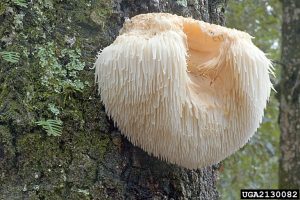
Lion’s Mane mushroom. Credit: Robert Smith; Cabin Bluff Land Management; Bugwood.org
In addition, the UF fungal herbarium is participating in a National Science Foundation-funded project to digitize and database as many US macrofungi collections as possible. This project, the Macrofungi Collection Consortium, includes 34 institutions in 24 states. The project began in July 2012 and will aim to capture data for roughly 1.3 million fungal specimens.
With that said, there is enough scientific research out there to conclude mushroom identification is indeed difficult. Many mushrooms look similar, but are oh so different!
If you are truly interested in eating what you forage MAKE time to study, with experts! Mushrooms, particularly those you plan to eat that are not identified correctly could send you to the emergency room … or worse. The toxicity of a mushroom varies by how much has been consumed. Poisoning symptoms range from stomachaches, drowsiness and confusion, to heart, liver and kidney damage. The symptoms may occur soon after eating a mushroom or can be delayed for six to 24 hours.
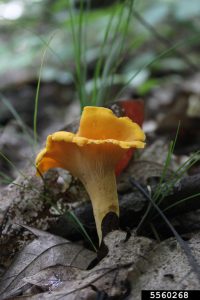
Chanterelle mushroom. Credit: Chris Evans; University of Illinois; Bugwood.org
Delayed symptoms are common. Seek help immediately if you think you may have eaten a poisonous mushroom, even if there are no obvious signs of toxicity. Call the Poison Center’s 24-hour emergency hotline at 1-800-222-1222. You will receive immediate, free and confidential treatment advice from the poison experts.
And if you are determined to make foraging for food a recreational hobby or even want to learn more about what is in your Florida yard, the book Common Florida Mushrooms by University of Florida’s Institute of Food and Agricultural Sciences Emeritus Faculty Dr. James Kimbrough, identifies and describes 268 species of mushrooms found in the sunshine state.
Most importantly, teach your children to NEVER eat any mushroom picked from the ground. It is indeed better to be SAFE than sorry.
People who are interested visiting the fungal herbarium should contact:
Dr. Matthew Smith
email: trufflesmith[nospam]@ufl.edu
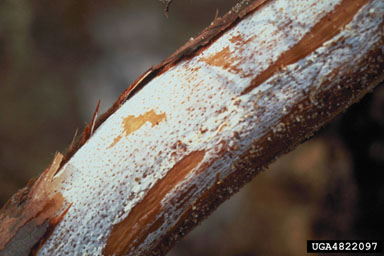
by Matt Lollar | Apr 23, 2018
Recently, an Extension Agent in the Florida Panhandle received a picture of some mushrooms popping up in a client’s garden. These particular mushrooms were in a spot where leftover mushroom compost had been dumped. The compost was previously used to grow oyster mushrooms and the client was hopeful that she had more oyster mushrooms growing in her yard. Unfortunately, the lab results came back stating the mushrooms in question were Armillaria spp.
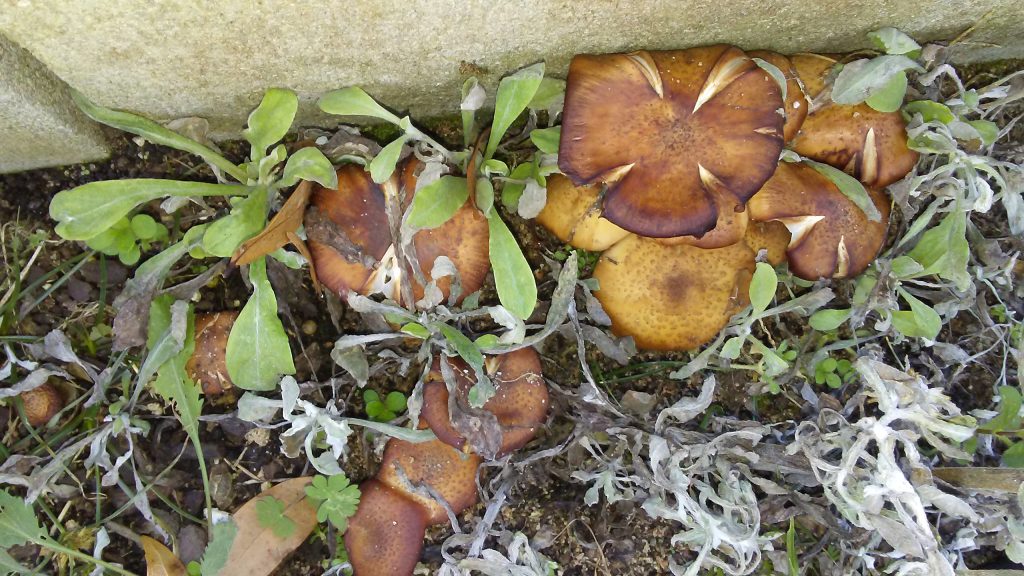
Armillaria spp. in the garden. Photo Credit: University of Florida/IFAS Extension.
Armillaria spp. cause root rot of trees and shrubs throughout the world. The fungus infects the roots and bases of trees, causing them to rot and eventually die. Some species of Armillaria are primary pathogens that attack and kill plants, but most are opportunistic pathogens that are attracted to unhealthy or stressed plants. Fruiting structures of the fungi can be recognized by the clusters of yellow to brown-colored mushrooms that emerge during wet conditions. However, the mushroom caps sometimes never form and the plant material needs to be inspected more thoroughly to find the disease culprit. Infected plants may have wilted branches, branch dieback, and stunted growth and should be removed and replaced with resistant species.

White mycelial fan under the bark of a root infected with Armillaria tabescens. Photo Credit: Ed Barnard
Management – The best method for controlling Armillaria root rot is with proper plant installation and maintenance. Planting plant material at the proper depth will allow the roots to breathe and reduce the opportunity for the roots to rot. Pruning tools should be sanitized between plant material. Proper irrigation and fertilization will also reduce the risk of plant disease and root rot. Lastly, you can choose to plant a diverse landscape with resistant species.
For more information on Armillaria root rot and a comprehensive list of resistant species, please view the EDIS publication: Armillaria Root Rot
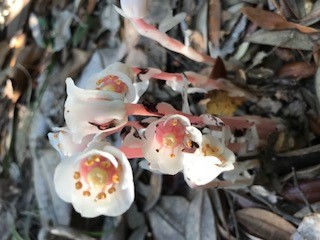
by Carrie Stevenson | Jan 25, 2018
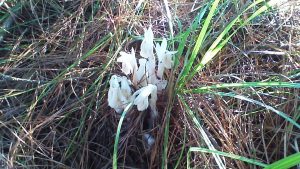
Ghost plant/Indian pipes emerging from the ground. Photo credit: Carol Lord, UF IFAS Extension
Imagine you are enjoying perfect fall weather on a hike with your family, when suddenly you come upon a ghost. Translucent white, small and creeping out of the ground behind a tree, you stop and look closer to figure out what it is you’ve just seen. In such an environment, the “ghost” you might come across is the perennial wildflower known as the ghost plant (Monotropa uniflora, also known as Indian pipe). Maybe it’s not the same spirit from the creepy story during last night’s campfire, but it’s quite unexpected, nonetheless. The plant is an unusual shade of white because it does not photosynthesize like most plants, and therefore does not create cholorophyll needed for green leaves.
In deeply shaded forests, a thick layer of fallen leaves, dead branches, and even decaying animals forms a thick mulch around tree bases. This humus layer is warm and holds moisture, creating the perfect environment for mushrooms and other fungi to grow. Because there is very little sunlight filtering down to the forest floor, the ghost flower plant adapted to this shady, wet environment by parasitizing the fungi growing in the woods. Ghost plants and their close relatives are known as mycotrophs (myco: fungus, troph: feeding).
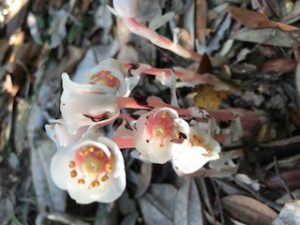
Ghost plant in bloom at Naval Live Oaks reservation in Gulf Breeze, Florida. Photo credit: Shelley W. Johnson
These plants were once called saprophytes (sapro: rotten, phyte: plant), with the assumption that they fed directly on decaying matter in the same way as fungi. They even look like mushrooms when emerging from the soil. However, research has shown the relationship is much more complex. While many trees have symbiotic relationships with fungi living among their root systems, the mycotrophs actually capitalize on that relationship, tapping into in the flow of carbon between trees and fungi and taking their nutrients.
Mycotrophs grow throughout the United States except in the southwest and Rockies, although they are a somewhat rare find. The ghost plant is mostly a translucent shade of white, but has some pale pink and black spots. The flower points down when it emerges (looking like its “pipe” nickname) but opens up and releases seed as it matures. They are usually found in a cluster of several blooms.
The next time you explore the forests around you, look down—you just might see a ghost!
by Matt Lollar | Jan 10, 2018
The Jackson County Master Gardeners are hosting a hosting a Mushroom Growing Workshop on Saturday, February 10 at the Jackson County Extension Office, 2741 Penn Ave., Marianna, FL.

Shiitake mushrooms growing on a log. Photo Credit: University of Florida/IFAS
MUSHROOM GROWING WORKSHOP
SATURDAY, NOVEMBER 18
9:00 AM to 2:00 PM
• Learn to grow shiitake mushrooms on logs.
• Learn about mushroom nutrition.
• Take home an inoculated mushroom log!
• A home cooked lunch is included!
Registration Fee $20.00
Includes Lunch
Space is Limited
To register, contact the Extension Service at (850)482-9620 or s.farr@ufl.edu.
Pre-register by February 7th.













